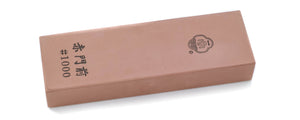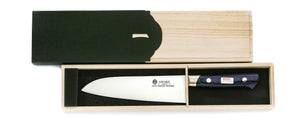Removing Rust on Knives
It's natural for knives to rust over time, and is something all knife owners will eventually have to deal with. No matter how good you are with your knife care, it can and will eventually happen.
It's normal for a knife to rust over time, and dealing with it effectively is part of owning high-end kitchen knives. Even if you're perfect with your maintenance routine, rust can still happen.
But when your knife rusts, what do you do next? You remove the rust! Leaving it only makes it worse, so it's important to remove rust the moment you notice it. Doing so leads to a healthier knife that can be used for a longer time, and prevents you needing to spent money and time replacing your kitchen knives.
This article will tell you the best ways to remove rust and get your knives back into a usable state quickly, especially if you're unsure how to. If you're looking for tips on how to prevent rust (which is just as important!), that article is over here!
If you have a Miracle Clean, we have specific instructions for those. You can read that here.
Removing Rust Can Save Kitchen Knives
We sometimes hear from customers that their knives have rusted and "become unusable." To think that a rusted knife can't be used is a very common statement. After all, if a knife suddenly turns completely black due to rust, it may seem beyond repair. Cutting ingredients with a rusty knife can be very unappealing, and some would imagine unhealthy too.
However, more often than not, knives can be brought back to good working condition, even if they are very rusty. Rust can be removed, and if you do so quickly your knives can be saved and used again for potentially many years. While of course professionals like us can do this, it is good to know how to be able to at home as well as this saves you money and time. In many cases, initial rust is only on the surface and can be removed easily with some polishing work.
It's crucial to address rust the moment you notice it, as leaving it untreated may lead to penetration past the surface. If rust penetrates too deeply into the knife, then repair becomes more difficult and eventually impossible. But if you are unsure if it can be removed or not, check with a professional or just try some light polishing work to see what you can take off.
Don't give up on your knife if you see rust, it's likely still savable!
Removing Rust Quickly Keeps Kitchen Knives Healthy
The environments in which knives are used are generally quite harsh for metals. This is why we see knives rust sometimes, even though the maintenance is being done perfectly.
Cooking requires constant exposure to water, and people often cut foods that contain high salt content or acidity (like onions, tomatoes, and citric fruits like lemons,) making it challenging to prevent rust on knives. Sometimes people live in humid environments, near salty beaches, or store their knives near water sources as well, which adds further challenges. Rust is a natural reaction to oxygen and water oxidising on iron, converting it it back into its natural state of iron oxide, and a lot of what we do with knives encourages this natural breakdown to occur. This is why maintenance, both in prevention and removal are so crucial.
In this sense, the occurrence of rust on knives can seem inevitable. However, once rust appears, it won't disappear on its own, so it's crucial to promptly remove rust when you first see it without delay. Much like how checking and caring for a car's oil levels is important, checking and caring for a knife's steel condition is important.
How To Remove Rust From Kitchen Knives
Rust in its initial stages is actually easy to remove. Since it's only on the surface of the knife, a light polishing is usually enough to remove visible rust spots. Again, it's important to get on this quickly as the worse the rust gets, the harder it is to remove and the more penetrative it gets into the blade, meaning you need to remove more knife material to save it.
When polishing, it's important to use an abrasive agent to effectively remove rust. If rust remains or isn't properly treated afterwards, there is a risk of it spreading again.
There's a few ways you can remove rust, which we've listed below:
Use a rust-removing rubber/eraser - Miracle Clean
One of the methods we apply in store is using a specialized rust eraser called Miracle Clean. You may see this as ミラクルクリーン or mirakurukuriin in Japanese. We recommend Miracle Clean very strongly and sell it on our website here! This is our most recommended method.
Miracle Clean is a eraser-like tool for knives that contains abrasive agents. By using Miracle Clean to polish the rusted areas, even large amounts of surface rust can be effectively removed. Some people will purchase blade oil and Miracle Clean together when they buy knives, as they are inexpensive additions that allow you to use your knife for many years.
The key to successfully removing rust is to follow the grind marks or lines on the knife's blade. Polish along these marks using the Miracle Clean and the rust should come off easily, leaving a beautiful knife in its place. We have a full guide on how to use Miracle Clean, which you can read here.
Use water-resistant paper
At places like home improvement centers or tool and hardware stores, you'll find various kinds of abrasive paper. Some of them are waterproof or water-resistant, and these can be used for rust removal.
Much like whetstones, abrasive papers comes in various coarseness or grit levels. The severity of the rust determines what coarseness you should use - larger spots of rust should use a coarser grit, and finer grits work for smaller areas.
Types of abrasive papers can include sandpaper, waterproof paper and air-sanding paper. In the case of knives, it's recommended to choose waterproof paper. This is because knives themselves are best sharpened with water, so this makes the paper practical for other future uses, such as polishing or restoring a knife's handle.
Polish using cleanser
If you want to remove rust using items you have at home, you can use a cleanser to polish the knife. Cleansers typically contain abrasives, allowing you to remove rust.
Apply the cleanser to the knife and use the back of a sponge to polish the blade. With a bit of work, the rust should come off. If the rust is more severe, consider using a metal scrubber or steel wool instead of a sponge for better results. Keep in mind using a metal scrubber or steel wool will cause polishing scratches and is a destructive way to remove rust, so use this method as a last resort.
If you're running into trouble, consider one of the other, more specialised methods above such as Miracle Clean. Alternatively, feel free to contact us if this is tricky, isn't working or if your knife is a special heirloom piece! We can always help you with rust removal on your knives - provided you reach out to us before the rust penetrates too deeply. We're specialists in sharpening and rust removal is a part of that process, so we can bring many knives back to a wonderful state.
Don't give up on your knives! Prevent rust first, but if you aren't able to they can still be saved!
Recommended Product: Miracle Clean
As we wrote earlier in this article, using Miracle Clean is a great way to keep your knives in good condition, used by professionals and home users alike. While we use a combination of products in store to bring back the best finish possible, we do use Miracle Clean on a daily basis. We carry it in two sizes, but for most home users the smaller size is sufficient. You can buy it from us below, but please keep in mind we only sell such products if purchased with a knife at the same time. We also have it in our Osaka store, too - plus in person we can show you how to use it.
Purchases of Miracle Clean that do not have a Sakai Ichimonji Mitsuhide knife in the same order will be cancelled and refunded. Please contact us if you need further information, or want to attach one to an existing unshipped order.































